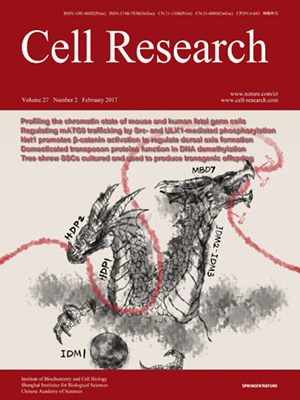
Volume 27, No 2, Feb 2017
ISSN: 1001-0602
EISSN: 1748-7838 2018
impact factor 17.848*
(Clarivate Analytics, 2019)
Volume 27 Issue 2, February 2017: 241-252 | Open Access
ORIGINAL ARTICLES
Long-term propagation of tree shrew spermatogonial stem cells in culture and successful generation of transgenic offspring
Chao-Hui Li1,2,3, Lan-Zhen Yan4,5, Wen-Zan Ban1, Qiu Tu4,3, Yong Wu4,3, Lin Wang1,2, Rui Bi4, Shuang Ji1, Yu-Hua Ma5, Wen-Hui Nie1, Long-Bao Lv5, Yong-Gang Yao3,4,5,6, Xu-Dong Zhao4,5 and Ping Zheng1,2,5
1State Key Laboratory of Genetic Resources and Evolution, Kunming Institute of Zoology, Chinese Academy of Sciences, Kunming 650223, China
2Yunnan Key Laboratory of Animal Reproduction, Kunming Institute of Zoology, Chinese Academy of Sciences, Kunming 650223, China
3Kunming College of Life Science, University of Chinese Academy of Sciences, Kunming 650204, China
4Key Laboratory of Animal Models and Human Disease Mechanisms, Kunming Institute of Zoology, Chinese Academy of Sciences, Kunming 650223, China
5Primate Research Center, Kunming Institute of Zoology, Chinese Academy of Sciences, Kunming 650223, China
6CAS Center for Excellence in Brain Science and Intelligence Technology, Chinese Academy of Sciences, Shanghai 200031, China
Correspondence: Ping Zheng, Tel: +86-871-68125422; E-mail: zhengp@mail.kiz.ac.cn; Xu-Dong Zhao, E-mail: zhaoxudong@mail.kiz.ac.cn; Yong-Gang Yao,(yaoyg@mail.kiz.ac.cn)
Tree shrews have a close relationship to primates and have many advantages over rodents in biomedical research. However, the lack of gene manipulation methods has hindered the wider use of this animal. Spermatogonial stem cells (SSCs) have been successfully expanded in culture to permit sophisticated gene editing in the mouse and rat. Here, we describe a culture system for the long-term expansion of tree shrew SSCs without the loss of stem cell properties. In our study, thymus cell antigen 1 was used to enrich tree shrew SSCs. RNA-sequencing analysis revealed that the Wnt/β-catenin signaling pathway was active in undifferentiated SSCs, but was downregulated upon the initiation of SSC differentiation. Exposure of tree shrew primary SSCs to recombinant Wnt3a protein during the initial passages of culture enhanced the survival of SSCs. Use of tree shrew Sertoli cells, but not mouse embryonic fibroblasts, as feeder was found to be necessary for tree shrew SSC proliferation, leading to a robust cell expansion and long-term culture. The expanded tree shrew SSCs were transfected with enhanced green fluorescent protein (EGFP)-expressing lentiviral vectors. After transplantation into sterilized adult male tree shrew's testes, the EGFP-tagged SSCs were able to restore spermatogenesis and successfully generate transgenic offspring. Moreover, these SSCs were suitable for the CRISPR/Cas9-mediated gene modification. The development of a culture system to expand tree shrew SSCs in combination with a gene editing approach paves the way for precise genome manipulation using the tree shrew.
10.1038/cr.2016.156
FULL TEXT | PDF
Browse 1940


